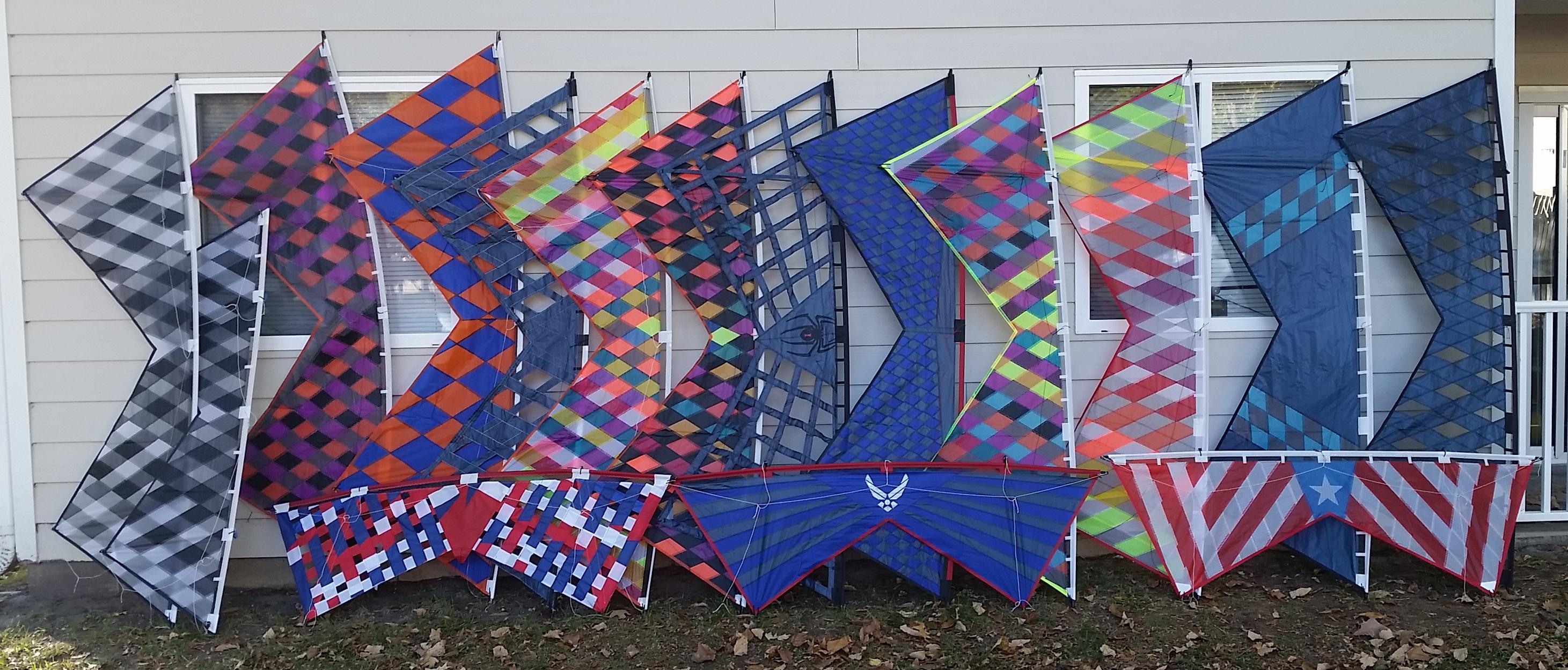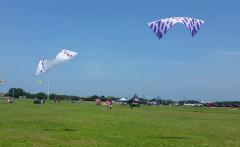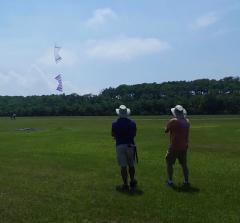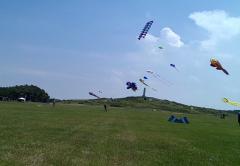-
Posts
3,015 -
Joined
-
Last visited
-
Days Won
332
Content Type
Profiles
Forums
Gallery
Downloads
KL Shop
Blogs
Articles
Everything posted by riffclown
-
From the album: riffclown's kite album
Hiding in a tree.. -
@Corey Bell, I'll reach out to you when I get back to the mainland.. I have some extras and we'll work something out.
-
@John Barresi Thanks for the suggestion. Literally an ideal spot for anything onshore winds.
-
I brought 4 kites with me. Scrapestry III (Full Sail), Gray II (Full Sail 72"), Red White and Blue Vented. (72) and White with a touch of Purple (MV) The Last 2 are all that got flown. A bit too much wind for a full Sail today.
-
Hopefully will be there today to fly kites. Will be my only real me time for the trip. Whipping winds predicted..
-
-
New Drawing is up. Locking this one down.
-
From the album: riffclown's kite album
Couldn't resist. B1-B with the kite.. Not in Kansas any more.. -
Looks good. Had trouble following the link but I found the spot on the map. Anyone local to the area that would like to try and meet up to fly quads soon??? Will be in that area in the very near future..
-
Any good spots to fly a quad near the area?
-
To tighten up the leading edge sleeve during construction many of us (that are still using screen) simply use 2" Dacron. After the fold and sew it's a very tight sleeve for standard rods. SLE Rods simply won't fit. For those using holes instead of screen, I assume they use their proper width (3" or 4") and fold 1" over to give the proper size sleeve and still have that extra inch or two to use the punch process. Quite Simply, 2" Dacron folded perfectly and sewn with a 3 step zig zag stitch yields the tighter LE sleeve mentioned by Paul and that's Whether the next segment below is screen or a separate piece of dacron. Experimenting with different fabrics from Dacron to Mylar backed Ripstop can be used to adjust the overall weight of the LE efforts. Thanks for the mention re: the triangle pocket, The only drawback to the pocket is "it is a pocket"..It can and will collect sand and/or debris.
-
-
From the album: Wright Kite Festival 2019
-
From the album: Wright Kite Festival 2019
-
From the album: Wright Kite Festival 2019
-
From the album: Wright Kite Festival 2019
-
From the album: Wright Kite Festival 2019
-
From the album: Wright Kite Festival 2019
-
From the album: Wright Kite Festival 2019
-
From the album: Wright Kite Festival 2019
-
Quick 2 minutes worth of video. Winds less than 5 and dropping to much less than 5. The kites in the background are indicative of the conditions..
-
No, this isn't about kite vents this is about kite advice. I feel the need to vent a bit. I've recently heard, read or overheard lots of advice to new fliers. This advice comes from all sorts of seasoned fliers (including me). The problem is our advice is sometimes completely overkill for someone just starting out in the world of kite flying. The problem with some of this advice (including mine) is what works for one person doesn't work for everyone and we can collectively turn new fliers off to kiting even though that not our intentions. They ask fairly simple straightforward questions and we all want to help but we simply overwhelm them with information of varying relevance. A few do step to that level quickly and may become better fliers. A few get completely discouraged and simply back off. (I saw that happen this weekend and that's why I started coming up with this post.) Unfortunately many times we don't seem to notice and that is a shame. Just to point out an example using my own advice. Not everyone wants their Symphony turned into 4 lines BUT, I seem to respond with that tact most of the time when that particular kite get mentioned. Yes, I'm proud of the result of my bridling technique but I now realize this isn't the best advice to a new flier unless they want to start the transition from dual to quad. Some people simply want the pull and fun of the 2 line version. Another example. French bridles do not make a newbie a better flier. They may help certain individuals tune in and progress to the intermediate level but to an absolute newbie French bridles are not even a discussion point yet. They can definitely impact Intermediate to Experienced fliers achieve that extra connection to the kite but for the beginner, they aren't doing axels or flic flacs yet. They are trying to get the kite in the air and stable. Until they have skills to get them there, a French Bridle is just an extra expense that won't teach them anything. Magic Sticks. Same conversation as the French Bridles. There are some exceptions like being able to simply park the kie without staking it but for a newbie that's still trying to get assembly and setup right, this conversation is way too early. Yet Another Example. Frames are also individual choices. As we progress in kiting we all tweak our frames from simply swapping out the SLE for a standard frames (IMO always good advice) to the 2 wrap, 3 wrap, race, green race conversation. Them we get into the hybrid combinations like a 3 wrap center with 2 wraps ends or even modular or travel frames. These are all very valid points but to a newbie, it's usually overkill and confusing. What a Newbie needs is that initial sense of; "When is a 2 wrap better than a 3 wrap for conditions?" "What are the advantages of a Race frame?" "How does a P300 Skyshark Frame compare to a 3 Wrap?" Kite Brands, We all have preferences and many of us have several brands in our bag. They each have their strengths and weaknesses. Things like Price, add-ons, and "simple startup" matter, ESPECIALLY when individuals are just starting out and learning. The most expensive new thing isn't going to make them a master flier overnight. We all know only practice can make a person better. Until the practice time is invested and basic setup/takedown, Line management are learned, the latest thing isn't going to make that huge difference. Sage advice to the quadline newbies. -Start with small movements and first get comfortable with the kite. Watch the basic instructional videos at Kitelife or elsewhere. -There simply is NO substitute for practice time on the handles. Buying additional gear will not make you a better flier. The only way to learn to not crash is to practice not crashing. -(This is opinion and your tastes and preferences may vary wildly.) If you are trying to save money, an all inclusive setup like the Rev EXP Which include the handles and lines may be your ideal starting point. (Springs engaged or not engaged are totally your call. Try both and establish your own opinion). A used setup is also probably a good choice. Learn line management, setup/take down, and basic positioning. Everything else starts from there. -It's critical you don't try to shortcut on kite line. It is your connection to the kite and trying to save money here will frustrate you far more than any incremental cost savings. FWIW, trying to save money on that first kite can yield the same types of frustrations. -Replacement Leaders for the handles may be the biggest single upgrade you'll want to start with. The stock leaders will work but as your skills increase even incrementally, a Leader change will enable you to explore your skills in ways no other single upgrade will provide. That upgrade is something we almost always agree on and will continue to grow with your skillsets. It will also act as a measuring stick as your skills grow. You'll see the tuning you use change over time. -Learn and know the wind range of your kite. It isn't until trying to fly it outside the range it was designed for that we often get into the Frame, venting and over-control types of conversations. Avoid flying that new full sail in the very strong wind. Once it's stretched, it is stretched forever. The solution there is vent it or start over with a new kite. -Fly OPK. (Other People's Kites) Most of us will gladly hand you our handles and will tell you what we think makes our kites and setup different or better. You can evaluate for yourself before spending money on those specific sails, those add-ons, tweaks or changes. The more you learn the more you can smartly experiment. -Figure out what works for you. Figure out what is limiting your flying ability other than practice. If you do run into an equipment related limitation, that's the time to really ask for the sage advice and again figure out what works for you. -Experience is the greatest teacher. The Experienced Flier can give advice and spend time with you but, your own experience is what you WILL learn from. How you internalize and use that advice from others is completely up to you. Sage advice to the sage advisors. -Know your audience, if they are ready to go down the rabbit hole take them there but please be able to sense when what is shared is too much. -State fact as fact and opinion as opinion. A simple "IMO" changes the whole tone for both the newbie and the seasoned flier. We all have opinions and we all have facts. Identify which one is being shared. -What works for you or me might not work for everyone. Emphasize at every stage of instruction that the new flier needs to find what works for them. FWIW, All of this is my opinion and based on not only advice I've given but also advice I've heard, read or listened to. I welcome responses from every direction. Let's not overwhelm the new flier until they are truly ready for the rabbit hole.
-
-
From the album: Wright Kite Festival 2019
-
From the album: Wright Kite Festival 2019






















